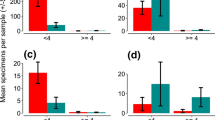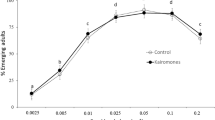Summary
Factors influencing development and survival ofCulex pipiens pallens immatures in polluted urban creeks were studied in Saga, Japan. Addition of food shortened developmental durations and increased pupal size in floating cages at only the least polluted site out of 4 study sites. There was no evidence for developmental delay due to overcrowding in natural populations. Survival was not increased by artificial feeding at any site. Using the developmental parameters obtained for caged cohorts, survival in natural populations was estimated from differences between the actual number and the expectation if there were no mortality. Pupation rates ranged from 1> to >10% by site and season. Mortality due to predation, evaluated from the difference in pupation rates between caged and natural populations, exceeded 30% in 4 out of 6 cases (twice at 2 sites and once at the other 2 sites). Lethal factors in the creek water caused the predominant mortality in 2 other cases. Regulation ofC. pipiens pallens population breeding in eutrophic, open creeks was discussed in the context of larval dispersal through behavioral interference.
Similar content being viewed by others

References
Chubachi, R. (1979) An analysis of the generation-mean life table of the mosquito,Culex tritaeniorhynchus summorosus, with particular reference to population regulation.J. Anim. Ecol. 48: 681–702.
Fisher, R. A. (1963)Statistical Methods for Research Workers (13th ed.). Oliver and Boyd, London.
Freund, J. E. (1967)Modern elementary statistics. Prentice-Hall, Englewood Cliffs, New Jersey.
Ikeshoji, T. (1966) Studies on mosquito attractants and stimulants part I. Chemical factors determining the choice of oviposition site byCulex pipiens fatigans andpallens.Jpn. J. Exp. Med. 36: 49–59.
Ikeshoji, T. and M. S. Mulla (1974a) Overcrowding factors of mosquito larve: isolation and chemical identification.Environ. Entomol. 3: 482–486.
Ikeshoji, T. and M. S. Mulla (1974b) Overcrowding factors of mosquito larvae: activities of branched fatty acid against mosquito larvae.Environ. Entomol. 3: 487–491.
Menon, P. K. B. and P. K. Rajagopalan (1981) Seasonal changes in survival rates of immatures ofCulex pipiens fatigans in different habitats in Pondicherry.Indian J. Med. Res. 73 (Suppl.): 136–138.
Mogi, M. (1978) Population studies on mosquitoes in the rice field area of Nagasaki, Japan, especially onCulex tritaeniorhynchus.Trop. Med. 20: 173–263.
Rajagopalan, P. K., G. D. Brooks and P. K. B. Menon (1976a) Estimation of natural survival rates of immatures ofCulex pipiens fatigans in open effluent drains in Faridabad, nothern India.J. Comm. Dis. 8: 11–17.
Rajagopalan, P. K., C. F. Curtis, G. D. Brooks and P. K. B. Menon (1977) The density dependence of larval mortality ofCulex pipiens fatigans in an urban situation and prediction of its effects on genetic control operations.Indian J. Med. Res. 65 (Suppl.): 77–85.
Rajagopalan, P. K., M. Yasuno and P. K. B. Menon (1976b) Density effect on survival of immature stages ofCulex pipiens fatigans in breeding sites in Delhi village.Indian J. Med. Res. 64: 688–708.
Rajagopalan, P. K., M. Yasuno and S. Russel (1975) Studies on the development and survival of immature stages ofCulex fatigans in nature.J. Comm. Dis. 7: 10–14.
Sokal, R. R. and F. J. Rohlf (1981)Biometry (2nd ed.). W. H. Freeman and Co. New York.
Southwood, T. R. E. (1978)Ecological Methods (2nd ed.). Chapman and Hall, London.
Southwood, T. R. E., G. Murdie, M. Yasuno, R. J. Tonn and P. M. Reader (1972) Studies on the life budget ofAedes aegypti in Wat Samphaya, Bangkok, Thailand.Bull. W. H. O. 46: 211–226.
Suenaga, O. and T. Itoh (1973) Studies on the filarial prevalence among dogs and the mosquito vectors in Nagasaki City, western Japan.Trop. Med. 15: 131–140.
Surtees, G. (1970) Studies on water movement and dispersion of mosquito larvae with special reference to control in rice fields.Bull. Entomol. Res. 60: 275–283.
Takahashi, R. M., T. Miura and W. H. Wilder (1982) A comparison between the area sampler and the two other sampling devices for aquatic fauna in rice fields.Mosq. News 42: 211–216.
Tsuda, M. (1964)Biology of polluted water. Hokuryukan, Tokyo. (In Japanese)
Author information
Authors and Affiliations
Rights and permissions
About this article
Cite this article
Mogi, M., Okazawa, T. Factors influencing development and survival ofCulex pipiens pallens larvae (Diptera: Culicidae) in polluted urban creeks. Res Popul Ecol 32, 135–149 (1990). https://doi.org/10.1007/BF02512595
Issue Date:
DOI: https://doi.org/10.1007/BF02512595



